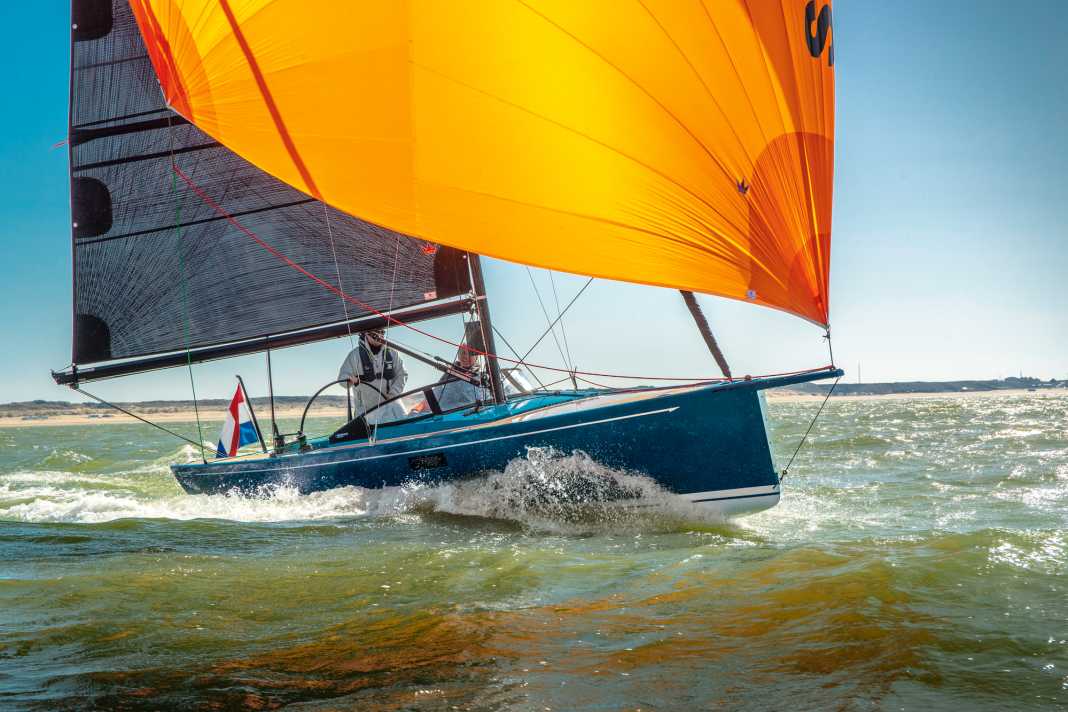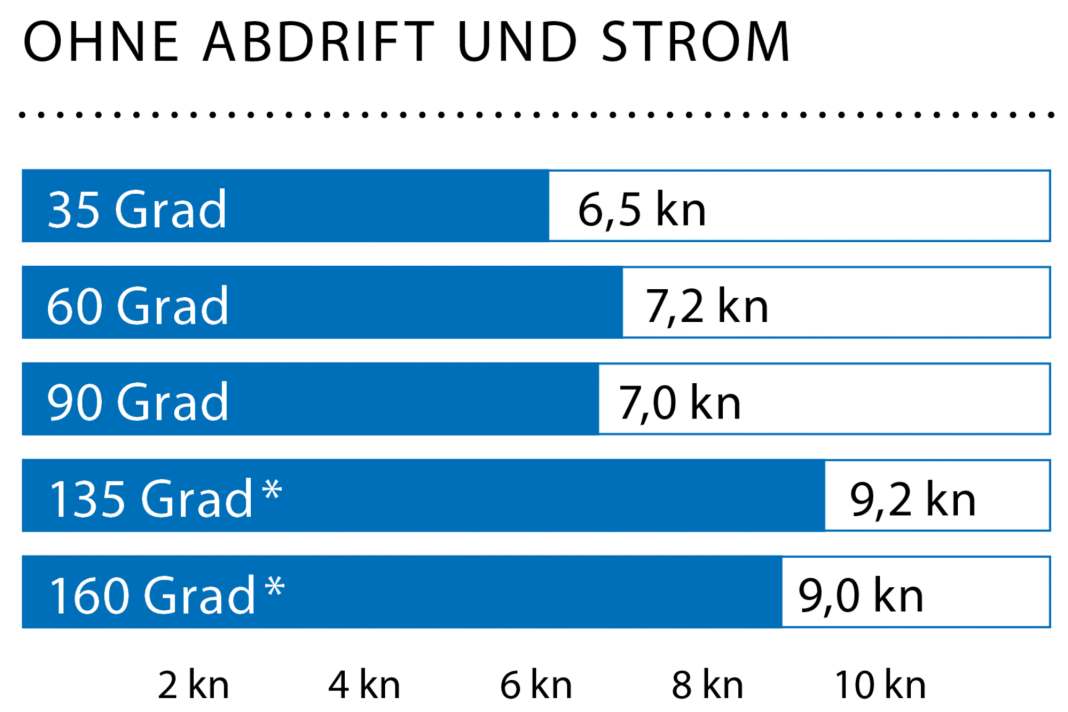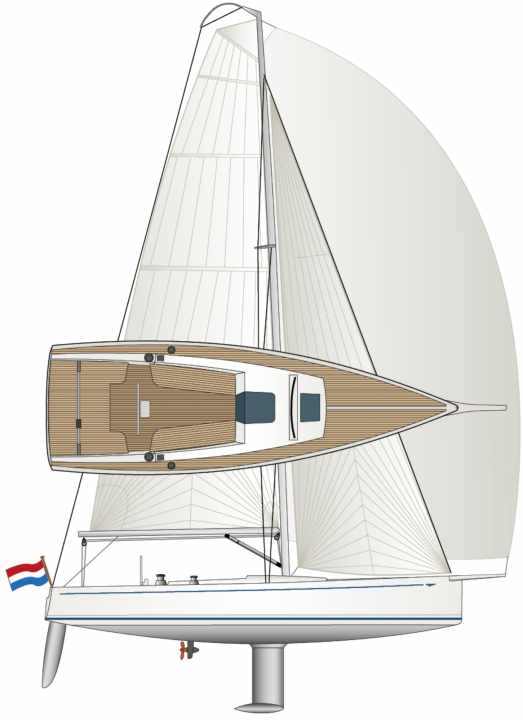





"Watch out, the wind is coming," says shipyard boss Dennis Hennevanger. He should know: The waters off IJmuiden are his playground. He knows his way around here like no other. And indeed: a few seconds later, the south-easterly wind picks up. 16, 18, 20 knots. The Saffier SE 27 thanks him with propulsion. The 63 square metre gennaker pulls. Drop off, onto the wave, and off goes the express train. The lugge hurries up, stumbles high, and even the 10 is left astern seemingly effortlessly.
Admittedly: The waves help, but there is no question that the Saffier would glide even without them. A mirror-smooth waterline at the transom and never the feeling that she is somehow sticking or doesn't want to. No, every gust, every shred of wind gives the ship legs. It has to be stiff and light at the same time.
A little less pre-balance on the rudder suits the concept better
The shipyard achieves this by using vacuum infusion construction with a core of Divinycell foam. A deep, slender L-shaped keel does the rest. It carries the lead ballast, which is very heavy at 47 per cent, very low down. This lowers the centre of gravity, which means that the boat hardly heels over in gusts, but bravely stretches its ample rig towards the wind.
However, with the large orange foresail, the helmsman has to react in good time to approaching wind fields and drop off sharply, otherwise the Saffier will be pulled into the wind. This is not dramatic, and she catches herself again. Nevertheless, full control is better. And faster. The shipyard wants to respond to this by changing the geometry of the rudder blade. That should remedy the situation. "I think we will then also provide a little less pre-balancing. Then she will have a little pressure on the rudder," explains Dennis Hennevanger. That will certainly look good on the ship.
This is because almost no pressure can be felt on the wind and the rudder is very neutral. This is generally slower than a slightly tilted rudder, which provides lift, and is also tedious for less experienced sailors because it requires a lot of concentration. And who wants to be constantly aiming at the lines on a relaxed outing on a Sunday afternoon when the wind is up? You'd rather have a wind edge that's easy to find. The positive message: even if you give away a few tenths of a knot, the speed of the Saffier is still enough to give most other boats a run for their money.
Pleasing values
In the present 16 to 20 knots of wind, she reaches a height of around 35 degrees to the true wind. This is enormous, but almost to be expected for a ship of this design. The measured value is slightly above what the polar diagrams say, but off IJmuiden it is always blowing from all possible directions. There was also a slight swell.
The speed was clear. A very decent 6.5 knots was possible. And that with the self-tacking jib. A 110 per cent headsail would be an option for light-winded inland waters. Off IJmuiden, the self-tacking jib was completely sufficient on the test day.
The boat runs at the reefing limit, good for testing. The described neutrality is also evident when there is a lot of pressure in the rig. However, this can be reduced to a tolerable level using various trimming options. Outhaul, a strong backstay, a kicker: it's all there. The traveller is also available, but part of the aft cushions have to be removed before it can be used. This is a little impractical, and it works quite well without overflow to leeward.
At 1.75 metres tall, the tester found it somewhat difficult to find a comfortable riding position. Behind the bike, the distance to the leeward bench is around 20 centimetres too great for relaxed sitting with support. There is also a nice spot on the coaming.
Control and access to the controls are maximised there. Only the support on the steering column is tricky, as it is very smooth. And the consequences of a slipping foot are rather dramatic. However, an anti-slip strip on both sides of the Jefa column helps to ensure a good grip. During the test, shipyard boss Hennevanger decided to install a footrest behind the wheel so that smaller people can also sail in a relaxed manner. Short decision-making processes - one of the advantages of a small and, moreover, fine shipyard.
Refreshing sailing
The beauty of a boat like the Saffier is that it is fun both upwind and downwind. On the way up, it can be circled right along the edge, and in future, with a different blade geometry, it will be even easier. And the upwind speed (VMG) is quite generous due to the good height. Thanks to the large sails, it is also quite fast back in the direction the wind is blowing. But that's even more fun.
Dropping off, raising the gennaker, luffing up and searching for waves - a delight thanks to the control provided by the single wheel. The sheet can even be placed on one of the two optional e-winches. As both drums can be operated from both sides, the crew or helmsman can easily readjust the large sail from windward. The Harken winches can both furl and close-hauled. It couldn't be easier.
And so it's suddenly there, the perfect moment. The boat is travelling at a relaxed 8 to 9 knots, the sun is shining, and a gust comes. Drop off, hit the wave exactly, and off goes the turbopost. The log indicates just under 12 knots, and that for quite a while. This is easy to call up and can also be achieved by less experienced helmsmen. That's how daysailing works. Great!
The day before, the wind was much stronger. That's when the shipyard boys took their new baby out and reached around 20 knots, they say. You could almost believe it. The shaky mobile phone videos also prove it. That is impressive.
No compromises?
So she can sail. The benches are not exactly long at 1.60 metres, but two adults can easily sit next to each other. And behind the helmsman there is a spacious sunbathing area. It has a small coaming on the sides and is therefore reasonably safe to lie on when travelling.
However, it is a bit of a shame that a bathing ladder is only included with the Saffier for an extra charge. A real day boat that will also be used for swimming should have more in stock than the ridiculous fabric ladder in the tin to fulfil the CE standard.
Keyword surcharge: If you want to have fun with the gennaker, you can certainly order the carbon bowsprit including blocks and two additional winches as well as the sail itself. This will then cost a few more euros. The wooden-look deck from Esthec is also not standard; the shipyard will quote the price for this on request. The same applies to a trailer. This is almost a must, because with a total weight including trailer of around 2500 kilograms, the Saffier can easily be towed on holiday behind a powerful vehicle.
Suitable drive concept
It is a seemingly bold step to offer the Saffier with an electric drive as standard. The diesel is available for an extra charge, which could well be a break with familiar habits for some customers. But: firstly, the target group for the SE line tends to be innovative anyway and often already drives an electric car privately, so the step towards an electric drive on board is a logical one. And secondly, the drive fits in perfectly with the concept: easy to operate, virtually maintenance-free and therefore worry-free and with a sufficient range - after all, you want to sail with the Saffier because that's exactly what it's made for. And if necessary, you can even sail to the harbour.
Consistently implemented
So an almost perfect boat? Perhaps. Because the compromises are hidden below deck. Yes, there is a toilet, but you can only sit on it in cramped conditions. Yes, there are four berths, but they are narrow and quite hard. The cushions are rather thin and therefore firm, as interior height was sacrificed for the pretty lines. This is understandable for a daysailer. If you are looking for sleeping space, the shipyard's more comfort-orientated SC line is for you.
The lack of ventilation in the cabin will also be acceptable for those who only spend the night on board occasionally. A hatch in the foredeck is of course possible on request. The concessions to a sporty daysailer have therefore been hidden below deck.
And it is precisely this consistency that makes the boat so good. In the shipyard's logic, SC line for comfortable sailing, SE line for more performance-oriented sailing, it all makes sense. It remains light and therefore agile and a pleasure to sail. The cabin serves as storage space, for changing after bathing and when the bladder pinches.
Want to sleep? Better in a holiday home or hotel. And if it's absolutely necessary once a season, for a trip with the sailing club or something similar, then it's still possible.
In fact, the Saffier SE 27 is not sold under 100000 Euro change hands. But then with fine cloth and all the comfort you could wish for in a daysailer. The price will not deter anyone, because the boat is either a fine addition to a much more expensive holiday home or a replacement for a larger and more expensive yacht or tender of a superyacht.
Incidentally, the bike also costs a surcharge. As expected, many customers will order it. However, a tiller would certainly be a good addition to the boat, as it increases the perceived agility even further. And that is exactly what you are looking for in a daysailer.
The measured values for testing the Saffier SE 27




The Saffier SE 27 in detail

Technical data of the Saffier SE 27
- Designer: Dean Hennevanger
- CE design category: C
- Torso length: 8,10 m
- Width: 2,55 m
- Draught/alternate..: 1,05/1,30, 1,60 m
- Weight: 1,9 t
- Ballast/proportion: 0,9 t/47 %
- Mainsail: 23,9 m2
- SW-Fock: 13,7 m2
- machine (Torqeedo): 4 kW/6 hp
Hull and deck construction
Iso-resins with Divinycell foam core in a vacuum infusion process. Hull, deck and bulkheads laminated
Price and shipyard
- Base price ex shipyard: 113,645 gross incl. VAT.
- Guarantee/against osmosis: 2/2 years
As of 05/2024, how the prices shown are defined can be found here!
Shipyard
Distribution
YACHT review of the Saffier SE 27
A roadster for the water: handy, fast, crisp, yet not bitchy or complicated. You'll want to go for a spin in the evening. Whether you want to sleep on board is a matter of taste
Design and concept
- + Consistent daysailer
- + Light and rigid
- - Low interior height
Sailing performance and trim
- + Good fitting arrangement
- + Direct control
Living and finishing quality
- + Fine workmanship
- - Lack of ventilation
- - Little storage space on deck
Equipment and technology
- + E-drive fits the concept
- + Large lying surface
- - Cushions disturb travellers
Video of the Saffier SE 27
The article first appeared in YACHT 10/2020 and has been updated for the online version.

